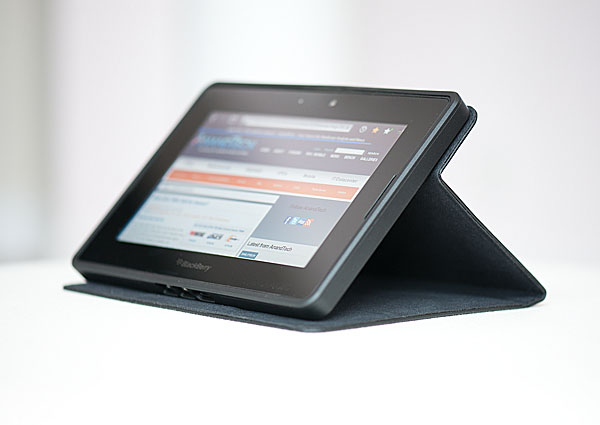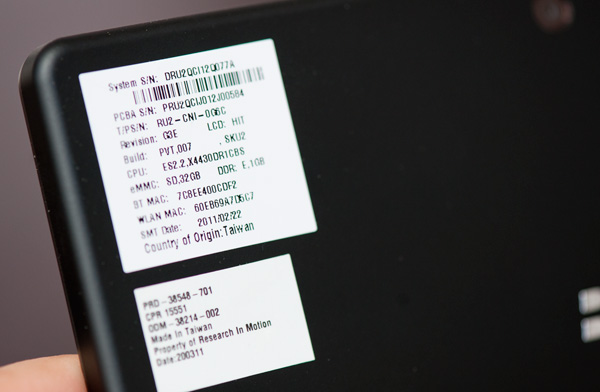The BlackBerry PlayBook Review
by Anand Lal Shimpi on April 13, 2011 9:00 PM EST- Posted in
- Tablets
- Smartphones
- RIM
- BlackBerry
- PlayBook
- Mobile
Final Words
One mistake I believe a lot of members of the press make is assuming that today's two-horse race is representative of the future of this industry. While Apple and Google are clearly out to a substantial lead, there are still more revolutions that will take place between now and when the mobile market finally matures. I'm not saying that Apple or Google won't end up on top, I'm just saying that it's not guaranteed they will either.
If you accept the philosophy that current leaders don't dictate future winners, then the market becomes much more interesting. For starters, it treats everyone as a potential leader. It also lets you focus on the value each player brings to the table, rather than the efforts of one.
The PlayBook is a reasonable experiment for RIM, but I need to see more to really recommend the tablet. We've been burned one too many times by companies serious about this market that have just fallen short on promises to keep things updated (ahem, Microsoft, Palm). RIM is hinting at something new every 6 - 8 weeks, and if that's truly the cadence then we very well might see the PlayBook turn into a significant player by the end of the year.
RIM definitely has the existing market to sell into. In fact, I'd say about the only type of user who should consider a PlayBook on day one is someone who already has a BlackBerry. If you have a BlackBerry and can't give it up but want a better browsing/media playback/consumer experience alongside it, the PlayBook is an excellent path to that. RIM was very smart in its implementation of BlackBerry Bridge. Keep all sensitive data on the BlackBerry, encrypt its connection to the PlayBook, but let you use the PlayBook to bring you what you're missing from the Android/iOS experience without having to carry two phones. Even though you're adding a second device to your mix, the PlayBook at least gives you a larger form factor to work with when you can use it.
It's everyone else that RIM really needs to convince. For your general consumer, the PlayBook is just missing apps (no email, no calendar, no Netflix, no Twitter). Although RIM would have you rely on webmail, I just don't believe that's ideal when both Apple and Google are shipping tablet optimized email clients today. RIM clearly has a plan to address these concerns, I'm just curious to see how long it takes to mature the PlayBook.
Ignoring immediate purchasing decisions, there are some things that RIM has done very right with the PlayBook. Full frame rate playback of 1080p High Profile H.264 content is a huge win. NVIDIA is promising this with Kal-El but RIM and TI deliver it here today. The only thing that's missing is support for .mkv containers and more audio codecs before we can really start putting tablets through our media streamer test suite.
With the exception of BlackBerry Bridge apps, multitasking is ridiculously smooth on the PlayBook. I've never been happy with Apple's multitasking UI and I've been dying for someone to copy webOS since its introduction, so kudos to RIM (and Palm). RIM does have to work on reducing application launch time and providing a consistent 60 fps experience across the OS. The issue with a super smooth UI is that the times when it isn't perfectly smooth really stand out.
I'm glad to see RIM experimenting with form factors. After using the Galaxy Tab 8.9 at CTIA I felt that may be the perfect balance between portability and functionality. The 7-inch PlayBook doesn't do the balance between functionality and portability as well, but it is small enough to actually carry around with me on a semi regular basis.
Battery life could use improvement. I'm not sure if this is an OS thing, battery capacity limitation or SoC problem, but it's real. While I don't normally have to worry about charging my iPad regularly, I do have to worry about charging the PlayBook.
There's a lot to like about the PlayBook, but unless you're an existing BlackBerry user you're better off waiting to see where RIM takes this thing.












77 Comments
View All Comments
legoman666 - Wednesday, April 13, 2011 - link
No email client? Really? Is that a joke?Ethaniel - Wednesday, April 13, 2011 - link
For now it seems, but that's clearly a sample unit. All I keep reading is "needs tuning" and "needs optimization", ergo, it's not ready, and they're going to launch it anyway. Those updates will have to be lightning-fast. I don't want to pay 500 dollars to be a beta tester...SimKill - Wednesday, April 13, 2011 - link
I'm actually surprised. This is because my cousin in India said that his friend in Dubai already bought it and has it for quite some time. Do you think there might be a reason why they are purposely delaying the American release?melgross - Thursday, April 14, 2011 - link
Probably, someone is lying about it, or they've gotten some illegally obtainedRe
Reduction model much as what happened the Apple's iPhone 4.
It's first being released in N. america, according to RIM.
vol7ron - Friday, April 15, 2011 - link
Why does everyone want to price around Apple? The more I look at these devices, the more I'm likely to get the color-nook and put Droid on it. Surely the hardware would be lacking, but the functionality would still be ballpark.16GB for $500 is ridiculous. These base models need to be in the $250-300 range.
michael2k - Friday, April 15, 2011 - link
Um, the raw materials for the iPad is about $260, meaning you can't expect to buy a 16gb tablet from any manufacturer, especially one with less buying power than Apple, for much less than $400 or so.From the iPad 2:
Display is $127
Flash is about $66 for 32gb, $35 for 16gb
Case & Battery is about $60
Mobo+Camera is about $60
So for any 10" tablet the cost if they gave it away for free would be $282 or so. Your nook "cheaps out" by having a 7" screen, only 8gb storage, a slower CPU, no cameras, and a much smaller battery. It only gets 8 hours with wifi off, the iPad 2 gets 11 hours with wifi on!
In other words you're only paying $180 worth of HW in the Nook, while the iPad gets you two 1GHz cores vs a 800MHz core, 11h of battery vs less than 8 hours, 10" and 1024x768 vs 7"@1024x600, 16gb vs 8gb, and of course, no guarantee of OS updates. You're complaint is ridiculous, actually, since almost no other manufacturer has been able to beat Apple on price yet except the Acer Iconia.
quiksilvr - Friday, April 15, 2011 - link
As much as I despise Apple, I have to agree to an extent. Yes that price is quite hefty, but if Apple didn't have it's cult following, it would have easily been on sale for $399. But thanks to idiot consumers, they can bump it up a Benjamin.michael2k - Friday, April 15, 2011 - link
And no one else can order in vast enough quantities to hit the $399 price.mcnabney - Friday, April 15, 2011 - link
I am starting to doubt the iSupply numbers you quoted.They price the very nice 9.7" IPS screen that Apple uses at $129 while the clearly inferior non-IPS screen the XOOM uses at $140. Their memory prices are also highly suspect, clinging to $2/GB for what are still really small drives compared where higher performing SSDs already are. I would guess that NAND prices for tablets are under $1/GB wholesale and in quantity.
michael2k - Friday, April 15, 2011 - link
Apple orders literally 2m 9.7" IPS screens a month, probably 40m this year alone. That gives them bulk purchasing power no one else has except the manufacturer of said screens.Motorola has to pay market prices, while Apple can literally buy an entire factory's output. http://www.isuppli.com/Display-Materials-and-Syste...
It doesn't help that the Japanese earthquake halted LCD production at major plants, either!
As for SSD chips, Apple is paying a premium to get density. The low end iPad has only a single SSD 16GB chip. The mid range iPad has one or two, and the high end has two 32GB chips. As soon as prices are good or capacity is good, I'm sure Apple will use a single 32gb chip on the low end, two 32gb chips for the middle, and 2 64gb chips on the high end.